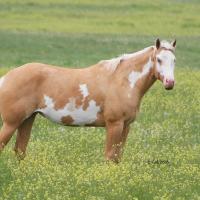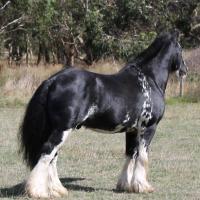What does Overo Mean? (And Why You Shouldn't Use It)
When discussing white patterns in horses it is never long before the word Overo is enters the conversation. But what does Overo really mean? To be blunt, the term Overo, only means “Any white pattern that isn't Tobiano”. This is a carryover from times past when distinguishing between white patterns was impossible for most breeders. A simple way to categorize white patterns was needed for registration. Since Tobiano is the most easily recognized white pattern it was named, while all other white patterns were lumped together. This resulted in Tobiano, Overo, and Tovero (Tobiano + Overo).
What White Patterns are considered Overo?
Over the years, breeders noticed that these “Overo” patterns tended to fall into three distinct groups. For many years these were termed Frame, Sabino, and Splashed White. With the discovery of Dominant White they were termed Frame, Sabino, Splashed White, and Dominant White. However, naming difficulties have arisen (discussed below). II prefer the traditional labeling of Frame, Splashed White, and Sabino.
Frame
One of the most distinctive of the “overo” patterns, Frame is called such because it tends to cause a “frame” of color around white spots on the body. It can cause large bald faces and blue eyes. White spots caused by Frame tend to have jagged edges. It is also known for leaving solid colored feet even though there is body white. The Frame mutation is the cause of Lethal White Overo Syndrome (named such because of it’s association with “overo” horses). A foal born with this malady will be white or almost white and will die shortly after birth from a malfunctioning or incomplete digestive tract. Because of the tragic results of frame to frame breedings a great deal of research was conducted to isolate the mutation that caused Frame (and thus Lethal White Overo). Frame, therefore, became the first white pattern to be testable in horses. The test, known as Lethal White Overo, is named for the syndrome that results from being homozygous (having two copies) of Frame. Frame is found in the EDNRB gene.
Splashed White
Splashed White is so named because the horses involved often look as if they are “dipped” or “splashed” with white paint. Usually these white markings have smoother edges than frame. Splash is known to cause leg white, and likes to cause bottom heavy face white and blue eyes (although not all Splash horses have blue eyes). It can be associated with deafness, if the white is extensive enough to affect the inner ear. There are two genes involved with the splashed white pattern with a total of 4 known mutations. The mutations are designated as SW1, SW2, SW3, and SW4. Splashed White 1 is an incomplete dominant. This means that horses with two copies of this gene have more white than horses with only one copy. SW2 and SW3 are thought to be embryonic lethal. There are not been a enough SW4 horses found to determine inheritance but it is not recessive and there is a high probability it is an incomplete dominant like SW1. The number of splash mutations will likely increase as some horses that look splashed white and have blue eyes test negative for known mutations. Splashed white is found in MITF and PAX3.
Sabino (aka Dominant White or White Spotting
In the past several years a great deal of research has been done on white patterns in horses. Although the original categories of “Overo” were Frame, Sabino, and Splashed White, we now know that white patterns in these categories are caused a multitude of mutations. Sabino….well, what we originally called Sabino, has gone through the greatest change. For many years, white markings that caused straight blazes, affected the back legs first (often upward pointing white), left dark eyes, and caused “roaning” or “roany” white body spots, were called Sabino. The first identified mutation that fit this description was called Sabino 1 but testing proved it was not widely spread and mostly found in “gaited” breeds such as Tennessee Walking Horses. Other occurrences were rare. However, no additional “sabino” mutations were found despite that fact that many horses like Clydesdales looked “Sabino”.
Researchers, however, began finding white pattern mutations at the same Locus where Sabino 1 was found (KIT gene). These white patterns were embryonic lethal when homozygous and caused an all white or nearly white horse. Because of the large amount of white caused by these patterns and their inheritance pattern they were called Dominant White and letter W used to designate them. First came W1 then W2, W3, W4…and it just kept going...The number of KIT gene mutations was astounding...and they were all termed Dominant White, but in 2013 something happened. A white pattern was found on the KIT gene that closely fit many of the identifiers originally used for Sabino. A wide blaze that did not include the eyes and leg white that tended to have points AND this new mutation was not embryonic lethal when homozygous. It all fit what we had known about sabino. But, it was on the KIT gene, and for many years KIT gene mutations had been designated W. So, W20 it was called, having been the 20th white pattern mutation found on KIT. But now what do we do? It doesn’t fit the pattern of a Dominant White. So what do we call it? Some would like to rename all the mutations formerly known as Dominant White to White Spotting. This allows the name to fit all of the known W mutations including those that aren’t quite so “White” and those that are yet to be discovered. There is however one glaring problem...Sabino 1. For this reason (and others) I feel that Sabino is still the best choice for these white pattern mutations. More more information read The Case for Sabino.
So where does this leave “Overo”?
Now we have categories and even known mutations for what used to be termed “overo”. So where does that leave Overo? In the past hopefully. Because we know so much more about how white patterns are inherited and classified, lets leave the old term behind. “Overo” and “Tovero” never had any real meaning other than “Lots of white but Not tobiano” and “Tobiano plus other white”. Lets stop using “Overo” entirely and call these white patterns by their names: Frame, Splashed White, and Sabino.
This article is dedicated to Jane Hands who for many years has been a crusader against the use of "Overo".


